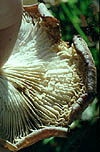
Cap usually scaly, often quite large
Fruiting body tough to extremely tough
Stalk central, well-developed
Spores inamyloid, smooth, elliptical
Oyster LignoTrich Subtribe

 Key to Gilled Mushrooms Key
Key to Gilled Mushrooms Key Agaricales Order
Agaricales Order White Spored Suborder
White Spored Suborder Tricholomataceae Family
Tricholomataceae Family Lignicolous Trich Subfamily
Lignicolous Trich Subfamily LentinoLignoTrich Subtribe
LentinoLignoTrich Subtribe




